Elon Musk once said something that might sound simple — but for anyone stuck in the learning process, it can be a wake-up call:
“Too much unfiltered information is just noise for the brain.”
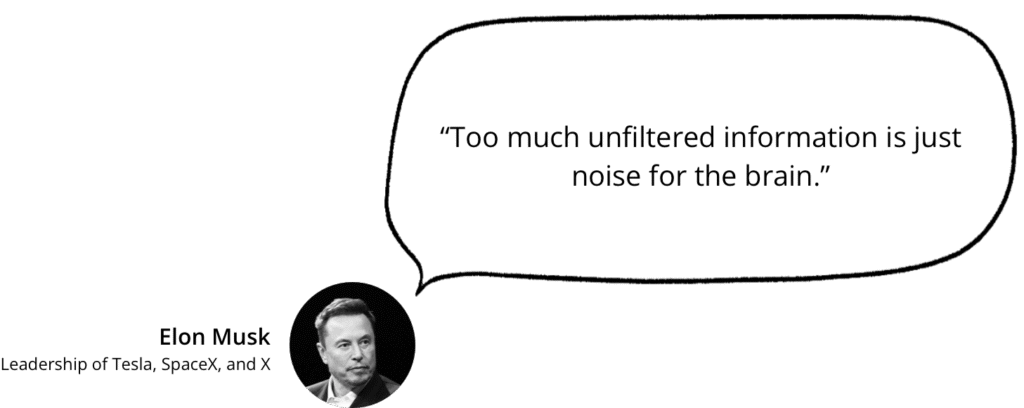
In other words, the more you know, the more distracted you get — if you don’t know what to ignore.
Your focus disappears.
You feel like you’re making progress…
But in reality, you’re just busy — not effective.
I still remember…
25 years ago, if I had a technical question,
I had to dig through Cisco books or ask another engineer for help.
Now?
You can get the same answer in seconds from Google or ChatGPT.
But here’s the catch:
Our brain hasn’t changed.
It’s still the same — with the same limited processing power.
And it’s not built for this flood of information — especially when 99% of it is irrelevant to your actual goals.
This is where a dangerous mental trap begins:
The illusion of knowledge.
Just because you read it… or watched it…
You think you know it.
But you don’t really know something until you do it.
Until you apply it.
That’s the difference between real skill and just “feeling productive.”
We watch videos.
We join courses.
We read articles.
We save tutorials on social media…
But when it’s time to build a simple EVE-NG lab?
We freeze.
Why?
Because consuming is fast. Easy. Feels good.
But building? Practicing? That’s uncomfortable.
And over time…
We become professional content consumers — not real engineers.
Worse?
We start telling ourselves:
“I’m trying. I’m putting in the effort.”
But are you really?
Or are you just staying busy to feel better?
We actually asked this in a recent survey.
More than 27% of network engineers said:
“Too many resources. I don’t know where to start.”

And that’s just one of the traps that keep you stuck for months — or years.
This is where the difference shows:
Between someone who just collects knowledge,
and someone who gets real results.
Between someone stuck in the illusion,
and someone with an Elon Musk mindset.
Musk lives in a world full of notifications, content, tools, and noise —
But he still focuses like it’s 1985.
He reads one book like it’s the only book that exists.
He doesn’t jump from tab to tab.
He doesn’t chase shiny things.
He learns, applies, and only then — moves forward.
That laser focus is why he can disrupt multiple industries at once.
Our problem?
We’re the opposite.
We know a little bit about everything — but go deep in nothing.
There’s a saying for this:
“You’re a mile wide, and an inch deep.”
We’re like an ocean… but only 10 cm deep.
That’s not just a weakness.
It’s a trap. A mental pattern.
Psychologists call it the Awareness Paradox:
The more you know…
The more options you see…
The less you act.
And yeah — it shows up like this:
- You quit one course halfway because another one looked better.
- You didn’t finish a video because the next one felt more exciting.
- You abandoned a lab because a “cooler” tool was recommended.
Sound familiar?
Even right now —
You’re reading this email.
You might even be enjoying it.
But if you don’t act on it after this…
You’re stuck in the same trap.
Just like the person who keeps buying new networking courses —
Not because they’re bad,
But because they never actually followed through on the last one.
So take a breath.
Because recognizing the trap is only the first step.
Now it’s time to break it — with real action, real structure, and a mindset that actually works.
Let’s get to it:
4 Real Solutions + A Simple Assessment Tool + Bezos Rule
You’ve already seen one of the biggest traps in learning: the illusion of knowledge.
You watch videos, save posts, maybe even buy a few courses — and you feel like you’re making progress.
But most of the time… you’re not.
That was just the first layer of the problem.
Now let’s go one level deeper:
❗The Illusion of Information
The illusion of information is when you’ve been surrounded by a lot of content — videos, articles, courses…
And it gives you the feeling that you’re ready.
But if that content isn’t aligned with what you actually need right now, or if it hasn’t been filtered properly…
It just kills your focus.
And instead of helping you move forward, it keeps you stuck in place.
You might ask:
“Okay, Ali — what’s the difference between the illusion of knowledge and the illusion of information?”
Here’s the simple answer:
- The illusion of knowledge makes you think you know something (when you haven’t actually done it yet).
- The illusion of information makes you unsure where to even start (because you’ve lost the ability to decide).
Both stop you from taking action.
The only difference? They trap you in different ways.

A real-world example from business:
Back in 1985, Coca-Cola made a bold move after 100 years in business.
They launched a new flavor: New Coke
During blind taste tests, people said they liked Pepsi more — it was a little sweeter.
Coca-Cola executives quickly decided:
“People want more sweetness!”
So they launched New Coke with massive marketing and production.
What happened?
Just 79 days later — the product was pulled from the market.
People hated it.
Why?
Because those taste tests were just a sip — not a full can.
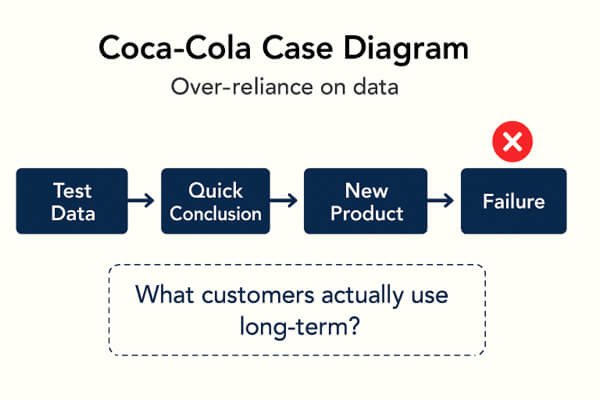
That sweetness felt good for a second… but over time, it became too much.
The executives had buried themselves in charts, surveys, and data…
But nobody asked the key question:
“Is this something people will actually enjoy in real life?”
We do the same thing.
We buy a course because it was on sale.
We watch a video because the title sounded exciting.
We save a PDF because “we’ll read it later.”
But did we really need it? Or did we just want a quick dopamine hit?
Some information is actually interesting:
- What’s the difference between STP and RSTP?
- How exactly does BGP work in large data centers?
But if you can’t:
- Open a switch
- Configure a port
- Run a ping and fix an error
Then none of that turns into real skill.
— Information is just the raw material.
— Skill = When you use that information to build something.
— Knowing ≠ Doing
— Feeling productive ≠ Real progress
So what’s the solution?
Let’s break it into 4 clear, practical steps — before we get to the self-assessment tool.
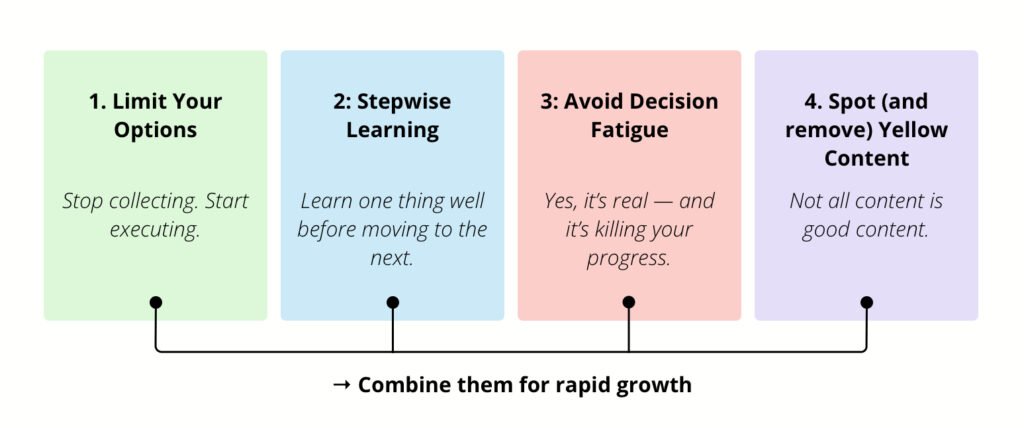
Solution 1: Limit Your Options
(Stop collecting. Start executing.)
This is exactly what the book The Art of Thinking Clearly talks about.
When you have too many options, your brain shuts down.
Here’s the rule:
Until you’ve executed what you just learned, you’re not allowed to move on to the next thing.
Let me show you what that looks like:
- You watched a video on Subnetting? Don’t just watch — go subnet a few IP addresses on paper or with a calculator.
- You downloaded a VLAN scenario? Don’t just read — go build it in your simulator.
- You read an article about NAT? Spin up a real lab and try it yourself.
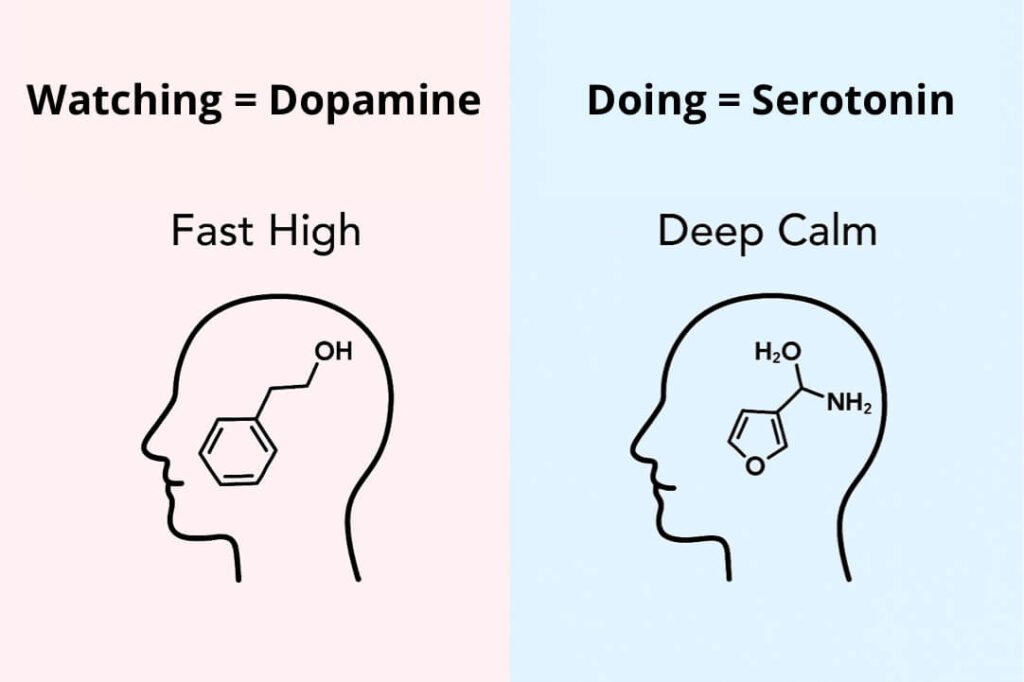
And this isn’t just a mindset trick — it changes your brain chemistry:
When you watch content, your brain gives you a hit of fast dopamine (A short-term rush. Addictive. Fleeting.)
But when you actually do the thing?
Your brain produces long-term serotonin (A deeper, longer-lasting sense of satisfaction.)
In short: Your brain shifts from being a content consumer → to becoming a skill builder.
Solution 2: Stepwise Learning
(Learn one thing well before moving to the next.)
At Dynamips, we call this stepwise learning.
Every skill is like a stair step.
Until you’re standing firmly on one — don’t take the next.
That means:
- Don’t touch OSPF until you’ve really done Static Routing.
- Don’t try ACL until you’ve built VLANs in multiple labs.
- Don’t chase something new until you’ve mastered the current one.
Because being 100 at one thing is way better than being 20 at five.
And when you work this way, your brain starts building deep skills — not surface-level knowledge.
Solution 3: Avoid Decision Fatigue
(Yes, it’s real — and it’s killing your progress.)
Ever had this happen?
- 5 browser tabs open with “what to learn next”
- 3 half-finished courses in your panel
- A giant note that says “stuff I should study someday”
You’re not lazy — your brain is just tired.
Not from learning.
From deciding.
The book The Art of Thinking Clearly (chapter 53) explains it well:
Even choosing food from a restaurant menu can lower the quality of your next decisions.
And this isn’t theory — it’s backed by research.
That’s why Elon Musk, Mark Zuckerberg, and Steve Jobs wore the same outfit every day.
They didn’t want to waste brainpower on small choices.
And now you?
- 4 learning tabs open?
- Subscribed to 20 Youtube channels?
- Bought 3 courses and started them all?
You’re dealing with decision fatigue.
And until you fix that, nothing you learn will stick.
Solution 4: Spot (and remove) Yellow Content
(Not all content is good content.)
Some content looks amazing on the outside — but it traps you in fake progress.
We call this yellow content.
How do you know if something is yellow content?
Here are 3 red flags:
- It encourages consumption, not execution.
“Just watch this video…”
(Instead of “Try this lab yourself.”) - It oversimplifies the problem.
“Learning networking is easy — just use the right tools!”
(But you and I know: no tool replaces actual hands-on practice.) - It makes unrealistic promises.
“Learn CCNA in 7 Days — No Experience Needed!”
“Go from Zero to Network Engineer in 30 Days!”
Those promises feel good — but they don’t help you grow.
They’re like chocolate. Or like painkillers.
They make you feel better in the moment — but the root problem stays untouched.
If a piece of content makes you feel good but doesn’t push you into action?
That’s yellow content. Delete it.
Now it’s time to find out where you really stand.
We built a very simple tool — but it can create deep clarity.
We call it:
The Self-Assessment Table
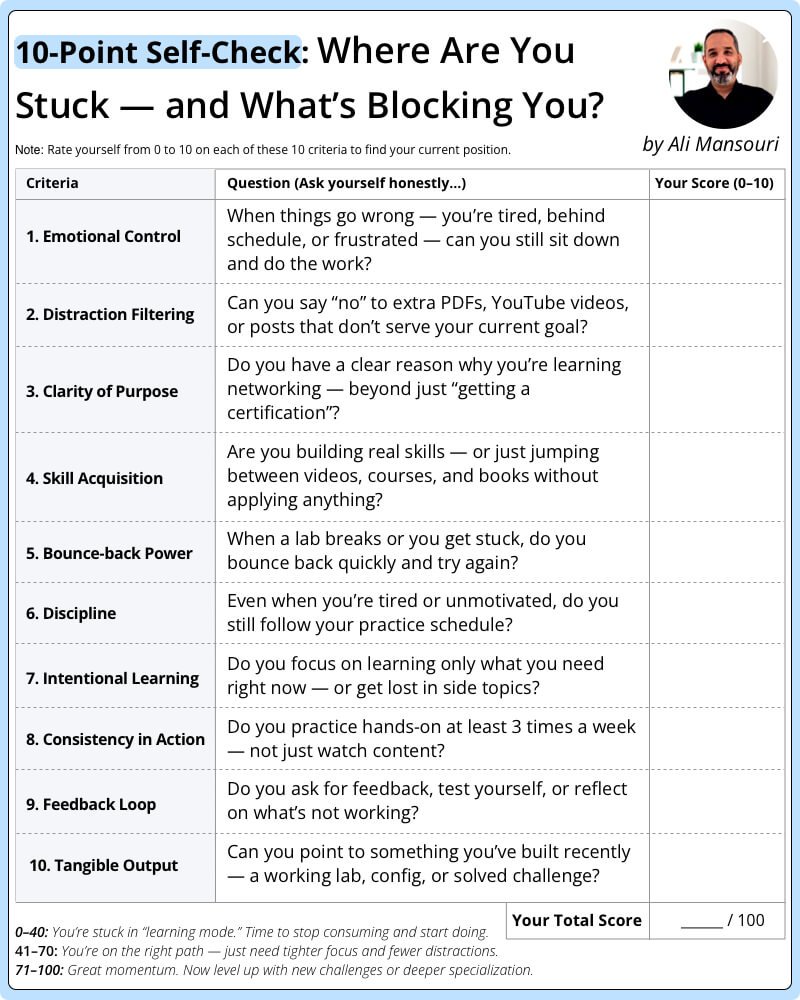
It helps you quickly, honestly measure:
Are you actually making progress?
Or are you just distracting yourself with more content?
Because if you can’t measure it — you can’t fix it.
How does it work?
We created 10 simple criteria — from “emotional control” to “consistent output.”
All you have to do is score yourself from 0 to 10 on each one.
The more honest you are, the more helpful this becomes.
You can download the PDF version here
Or fill out the online version here (no email required)
We’ll use the anonymous results to create even better tools and guides.
What does your total score mean?
→ 0–40: You’re stuck in “learning mode.” Time to stop consuming and start doing.
→ 41–70: You’re on the right path — just need tighter focus and fewer distractions.
→ 71–100: Great momentum. Now level up with new challenges or deeper specialization.
And the most important insight of this section?
The Jeff Bezos Rule:
“If you’re 70% confident in a skill — it’s time to act.”
Don’t wait for 100%.
After 70%, more waiting usually leads to the illusion of learning.
So right now:
- Download the self-assessment OR take the online version.
- Score yourself honestly
- Add up your score
- And if any area scores below 4 — that’s where your growth is blocked
Don’t fix it by watching another video.
Fix it by applying what you already know.
Burnout, the Success Trap, and Your Final Decision
By now, we’ve uncovered the real reason most people stay stuck:
- They think they “know” something — but never actually do it. (The Illusion of Knowledge)
- They consume tons of content — and forget the real goal. (The Illusion of Information)
- They jump from course to course — without ever mastering one real skill.
We also shared 4 powerful ways to break out of this cycle:
- ✔ Instead of collecting more, start executing.
- ✔ Learn just one thing at a time.
- ✔ Avoid decision fatigue.
- ✔ Stay away from flashy but shallow content.
And we gave you a simple self-assessment tool to help you figure out exactly where you are.
But here’s the catch:
Even if you fix all of that… There’s still one final trap that quietly pulls people backward:
Burnout on the Growth Path
A lot of people start strong.
They make progress. They get results.
Maybe even land a better job or earn more money…
But then what?
As soon as they reach some level of success,
the pace of daily life starts to outrun the pace of their growth.
Practice fades.
Study slows down.
And little by little, they fall into the illusion of “I already know this.”
And the moment a real problem shows up?
They fall back into the same old loop:
Watching… reading… but doing nothing.
Why?
Because they saw success as a peak, not a path.

But if you want to stay in the game — your mindset has to change.
You need to realize:
Real success is about staying on the path.
Not just touching the peak for a moment.
There will always be people selling shortcuts:
“Just watch this video — everything will click.”
“Get a 6-figure job in 30 days with this one course.”
But here’s the truth:
Success is not something you consume. It’s something you build.
And you only build it through real practice, repetition, and consistent action.
Now it’s decision time.
In this 3-part series, we gave you the full roadmap:
- We explained the problem
- We revealed the traps
- We gave you a table to assess yourself
- And we shared clear, simple, real-world solutions
There’s just one thing left:
Will you act on it? Or just move to the next piece of content?
If you choose the next video instead of action…
Let’s be honest — you’re not fooling anyone but yourself.
So right now, this is your moment of truth:
- Close this tab.
- Open EVE-NG.
- Launch that half-finished lab.
- Build something.
- Run a test.
- Do something real.
That one action?
It’s what separates the doers from the content collectors.
At Dynamips, we’re here to help you take that step —
By focusing on real labs, real practice, and real clarity.
Forget watching more.
Start building.
We’ve got your back.
This is the end of the email — but just the beginning of your journey.
— Ali
3 responses
You couldn’t have put it more straightforwardly; it was direct, staring you right in the eye. Truly useful, inspirational, and thought provoking.
Thanks very much, the information was helpful. I pray and hope to work with then to be able to improve my career for a better tomorrow.
thanks very much sir….
Amazing Content, Really Helpful